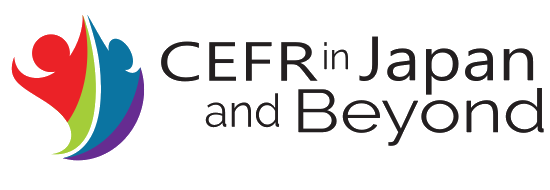Kaken 2
【研究背景・目的】Background and purpose of the research project
2012年に、国際的認知の高まっているヨーロッパ言語共通参照枠(Common European Framework of Reference for Languages、CEFR)を日本の教育文脈に適用したCEFR-Jの第1版(Version 1)が正式公開されました(http://www.tufs.ac.jp/ts/personal/tonolab/cefr-j/download.html)。CEFR-JではCEFRにおける6つのレベルが12のレベルに細分化され、前段階として、小学校外国語活動を意識したPre-A1レベルも設けられるなど、日本の学習者にとって到達段階をより実感しやすいものとなっている。一方で、2011年6月末に文部科学省により公開された「国際共通語としての英語力向上のための5つの提言と具体的施策~英語を学ぶ意欲と使う機会の充実を通じた確かなコミュニケーション能力の育成に向けて」(外国語能力に関する検討会,2011)において、「生徒に求められる英語力について、その達成状況を把握・検証する」とし、「中・高等学校は、学習到達目標を「CAN-DOリスト」の形で設定・公表するとともに、その達成状況を把握する」ことが提言され、各学校の文脈に合わせてシラバスや使用教材と関連させた、具体的な能力記述及び目標設定が喫緊の課題となっている。
こうした流れを受け、中・高等学校からの接続先である大学でもCan-Doリストの形で目標を明確に定めたカリキュラム作成が求められるようになることが予想される。全国語学教育学会(JALT)の「フレームワークと言語ポートフォリオ研究部会」(FLP SIG)では、本研究申請者が中心となり、主に日本の高等教育の文脈でのCEFRの適用可能性を探るべく、最新学術成果を踏まえて、具体的な実践例やリソースを教師に提供するための論文集を編纂した(シュミット他編,2010)。しかしながら、Can-Doリストを利用した優れた実践のノウハウが蓄積される一方で、そうした到達目標を意識した教授・学習スタイルと既存テキスト(教科書)との親和性は必ずしも高いとは言えず、テキストの目標設定などは、各実践者の工夫に委ねられている現状が指摘された。また、教師や学習者の自律を支援するための具体的道具立てが不足していることも示唆された。
Version 1 of the CEFR-J (see http://www.tufs.ac.jp/ts/personal/tonolab/cefr-j/download.html), an adapted version of the internationally acknowledged CEFR contextualized for the Japanese context, was published in March 2012. The CEFR-J divides the six levels of the CEFR into 12 sub-divisions, with a pre-A1 level for elementary school education etc. It is thought that this creates suitable levels of attainment for language learners in Japan. Furthermore, the need for syllabi and learning materials based on concrete language achievement levels for all levels of education has been a prescient topic since the Ministry of Education, Culture, Sports, Science, and Technology- Japan (MEXT) published the learner achievement goals in the form of can do lists in the “Five Proposals and Specific Measures for Developing Proficiency in English for International Communication” (Commission on the Development of Foreign Language Proficiency, 2011).
The need for clear goals in form of can do lists and related curriculums that connect Junior High School, Senior High School, and University level education should be met. The goal of the Framework & Language Portfolio Special Interest Group (FLP SIG, established within the Japan Association for Language Teaching [JALT]), whose members are at the centre of this research project, is to create resources that highlight the relevance of the CEFR and related matters for language education in Japan. The FLP SIG have emphasized the need for the dissemination of specific ideas and resources for educators to bring into classroom. You can refer here to a volume of papers published in 2010 (Schmidt et al., 2010 see http://tinyurl.com/CDSLEJB). However, while knowhow has accumulated regarding the use of can do lists etc., we cannot say that existing textbooks and materials reflect this knowhow. The majority of textbooks do not take responsibility for the establishment of learning goals and related pedagogical practices. Furthermore we suggest that the practices and principles that encourage teacher and learner autonomy need to be more prominent in learning materials.
そこで、本研究では、海外出版社から新たに出版されつつあるCEFRに準拠した大学英語テキストの分析を通して、言語教授項目や学習タスクを吟味するとともに、CEFR-Jの能力記述とも比較し、日本の高等教育の文脈に合わせた英語テキストを開発することを目的とする。また、教科書に付属する教授資料の整備や授業外の自律学習を支援する付属教材、さらには、言語ポートフォリオの開発等を通して、学習者や教師の自律性(Learner/Teacher Autonomy)を支援するための環境を整えることも目的とする。テキストの開発にあたっては、主に大学英語教育で用いられることを想定するが、2013年度より施行される高校新学習指導要領において、4技能を統合した授業を英語で行うことが求められるようになる背景を受け、特定の技能によらない、技能統合型の学習を念頭に置き、英語で書かれたテキストとすることにする。対象とするレベルに関しては、CEFRで「自立的言語使用者」の入り口とされるB1レベルからB1+、さらには社会で求められるB2レベルにすることを目標とすると同時に、レメディアル的取り扱いにより、「基礎的言語使用者」の出口とされるA2+レベルから脱却するためにも用いることができるようにする。
現在、CEFR-Jが開発されるなど、Can-Doリストを用いた日本の文脈に合わせた言語能力発達段階の記述がなされ、教室においてCan-Doリストを適用した先行事例が生まれつつある一方で、多くはCan-Doリストに合わせて既存の教材をアレンジする、または、教材に基づいてCan-Doリストを作成する試みに留まっている。海外出版社からもCEFR準拠教材が出版されつつあるが、Can-Doリストを提示しているだけのものがほとんどであり、日本の教室文脈への適用の工夫も要求される。また、自律学習支援環境の充実の点でも不十分な状況にある。
本研究では、国内外のCEFR研究の最新学術成果に基づき、日本の文脈に合わせた4技能統合型のCEFR準拠テキストを開発する点において意義がある。また、テキストを編纂するだけではなく、DVDやワークシート等の付属教授資料により教師自律性を支援し、自律学習教材や言語ポートフォリオも開発することで、学習者自律性を支援する点も特筆すべきであろう。加えて、ワークショップの開催により、教授者・開発者のコミュニティを形成することで、新学習指導要領下でのCan-Doリストを用いた中学校・高校英語教科書との接続においても貢献できるだろう。
With the purpose of developing a contextualized text for the Japanese Higher education context, we will analyze recent CEFR-informed textbooks from international publishers. There will be an emphasis on language descriptors and learning tasks, and comparing these with the proficiency descriptors of the CEFR-J. We will also look at the preparation of instructional materials supplementary to textbooks, and other additional resources, along with language portfolios that can foster an environment that encourages learner and teacher autonomy. We anticipate that the text will be suitable for English language classes at the university level, so we will correlate this with the new “Study of course guideline for foreign languages in senior high Schools” to be implemented in 2013. Keeping these study guidelines in mind, there will be a need for a four skills integrated skills textbook written in English. The text will aim for the entry level of an ‘independent learner’ (from B1 to B1+), up to level B2 (a level needed to interact in society). At the same time it can be used to breakthrough from the exit level of the basic user (A2+ level).
Presently, with the development of the CEFR-J, we can see encouraging signs of the use of language achievement levels in the form of can do lists that are contextualized to the Japanese context, along with continuing development of exemplar practices in relation to the use of can do lists. However such practice stop at arranging and creating can do lists for materials in question. Materials from international publishers are also informed by the CEFR, but generally just display a can do list. There is a need to develop knowhow to implement these tools in the classroom. Furthermore practices and principles that encourage autonomous learning are currently insufficient.
The significance of this project is to develop a contextualized CEFR-informed integrated skills textbook for Japanese learners of English. The textbook should be related to recent results of research on the CEFR. A point worth mentioning is that we will not only focus on textbook materials, but create a DVD, worksheets, and a language portfolio to support autonomous learning. Furthermore, by holding workshops we can build a community of practice of educators and developers. This project can also contribute to the goal of connect Junior High School, Senior High School, and University level education by developing can do lists that are related to those for Junior and Senior high School materials.

